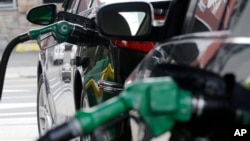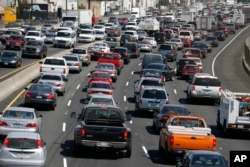The Trump administration went to work rolling back another Obama-era environmental regulation Wednesday.
Regulators announced they would review strict vehicle fuel efficiency standards finalized days before President Donald Trump took office.
Trump calls the rules "industry-killing regulations." But environmental and doctors groups say they are cleaning the air and helping Americans at the pump.
The rules now under review require an average of 54.5 miles per gallon (23 kilometers per liter) from an automaker's entire fleet by 2025.
"No conventional vehicle today meets that target," the Alliance of Automobile Manufacturers, an industry trade group, said in a February 21 letter to EPA Administrator Scott Pruitt. Hybrid and electric vehicles do, but they make up less than 3.5 percent of vehicles made today, the group said.
And with gas prices low, consumers are buying more trucks and SUVs and fewer fuel-efficient vehicles. That makes it harder to reach the fleetwide gas mileage target.
Automakers fear they will be punished for selling what consumers want to buy. They said it would cost $200 billion between 2012 and 2025 to comply with the rules.
"These standards are costly for automakers and the American people," said Pruitt.
Ahead of schedule
But supporters of such efficiency standards noted that the industry was already improving them ahead of schedule.
"There's no doubt that the current standards are reasonable and achievable," said Kristin Igusky at the World Resources Institute. "In fact, the industry as a whole has surpassed the vehicle standards in each of the last four years, while creating jobs and selling more vehicles than ever."
The EPA announced last November that more than 100 vehicles on the market already met 2020 efficiency standards, even as the industry hit a sales record.
"Rolling back vehicle fuel standards would make Americans spend more at the pump, leaving them with less for their families and basic needs," Igusky added.
"It's not an economic issue alone. It's a health issue," added Jonathan Patz, head of the University of Wisconsin Global Health Institute.
Patz spoke at Wednesday's launch of the Medical Society Consortium on Climate and Health, a new alliance of physicians groups representing more than half of the nation's doctors.
"To roll back these standards is going to harm our health,” Patz added.
The transportation sector releases about a quarter of the greenhouse gases in the United States, according to the EPA.
Low-hanging fruit
Although manufacturers are meeting fuel efficiency targets now, it may get harder as the 2025 deadline gets closer, according to industry analyst Kevin Riddell with LMC Automotive.
Riddell said automakers had "picked up a lot of the low-hanging fruit" in terms of increasing efficiency. "The newer technologies that they're looking at now are starting to add some considerable cost."
Plus, regulators have allowed truck efficiency to improve at a slower pace than that for cars. That changes in 2022, when the pace of truck improvements will have to increase.
"That's going to be a bigger challenge," Riddell said.
The industry says it is not opposed to raising fuel efficiency standards. But it says the Obama administration rushed them into place without considering the impact.
Review set for 2018
A midterm review of the rules is not due until April 1, 2018. The EPA finalized its decision not to change them on January 12, just before Obama left office.
With the Trump administration's announcement, Alliance of Automobile Manufacturers chief Mitch Bainwol said, "Now we will get back to work ... in carefully determining how we can improve mileage and reduce carbon emissions while preserving vehicle safety, auto jobs, and affordable new cars and trucks."
But in a global marketplace, automakers have more to think about than just EPA rules, Riddell noted.
"Even if these targets are eased up a bit," he said, "Europe is not going to ease up on their targets. China is not going to ease up on their targets."










